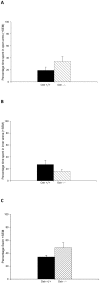Impairments in the initiation of maternal behavior in oxytocin receptor knockout mice
- PMID: 24892749
- PMCID: PMC4044031
- DOI: 10.1371/journal.pone.0098839
Impairments in the initiation of maternal behavior in oxytocin receptor knockout mice
Abstract
Oxytocin (Oxt) acting through its single receptor subtype, the Oxtr, is important for the coordination of physiology and behavior associated with parturition and maternal care. Knockout mouse models have been helpful in exploring the contributions of Oxt to maternal behavior, including total body Oxt knockout (Oxt -/-) mice, forebrain conditional Oxtr knockout (Oxtr FB/FB) mice, and total body Oxtr knockout (Oxtr -/-) mice. Since Oxtr -/- mice are unable to lactate, maternal behavior has only been examined in virgin females, or in dams within a few hours of parturition, and there have been no studies that have examined their anxiety-like and depression-like behavior following parturition. To improve our understanding of how the absence of Oxt signaling affects maternal behavior, mood and anxiety, we designed a study using Oxtr -/- mice that separated nursing behavior from other aspects of maternal care, such as licking and grooming by thelectomizing (i.e. removing the nipples) of Oxtr +/+ mice and sham-thelectomizing Oxtr -/- mice, and pairing both genotypes with a wet nurse. We then measured pup abandonment, maternal behavior, and postpartum anxiety-like and depression-like behaviors. We hypothesized that genetic disruption of the Oxtr would impact maternal care, mood and anxiety. Specifically, we predicted that Oxtr -/- dams would have impaired maternal care and increased anxiety-like and depression-like behaviors in the postpartum period. We found that Oxtr -/- dams had significantly higher levels of pup abandonment compared to controls, which is consistent with previous work in Oxtr FB/FB mice. Interestingly, Oxtr -/- dams that initiated maternal care did not differ from wildtype controls in measures of maternal behavior. We also did not find any evidence of altered anxiety-like or depressive-like behavior in the postpartum period of Oxtr -/- dams. Thus, our data suggest that Oxt lowers the threshold for the initiation of maternal behavior.
Conflict of interest statement
Figures



Similar articles
-
Normal maternal behavior, but increased pup mortality, in conditional oxytocin receptor knockout females.Behav Neurosci. 2010 Oct;124(5):677-85. doi: 10.1037/a0020799. Behav Neurosci. 2010. PMID: 20939667 Free PMC article.
-
Pervasive social deficits, but normal parturition, in oxytocin receptor-deficient mice.Proc Natl Acad Sci U S A. 2005 Nov 1;102(44):16096-101. doi: 10.1073/pnas.0505312102. Epub 2005 Oct 25. Proc Natl Acad Sci U S A. 2005. PMID: 16249339 Free PMC article.
-
Oxytocin receptors in the nucleus accumbens shell are necessary for the onset of maternal behavior.Front Neurosci. 2024 Jul 2;18:1356448. doi: 10.3389/fnins.2024.1356448. eCollection 2024. Front Neurosci. 2024. PMID: 39015375 Free PMC article.
-
Oxytocin and behavior: Lessons from knockout mice.Dev Neurobiol. 2017 Feb;77(2):190-201. doi: 10.1002/dneu.22431. Epub 2016 Nov 24. Dev Neurobiol. 2017. PMID: 27513442 Review.
-
The Oxytocin Receptor: From Intracellular Signaling to Behavior.Physiol Rev. 2018 Jul 1;98(3):1805-1908. doi: 10.1152/physrev.00031.2017. Physiol Rev. 2018. PMID: 29897293 Review.
Cited by
-
A Role for Oxytocin in the Etiology and Treatment of Schizophrenia.Front Endocrinol (Lausanne). 2015 Jun 3;6:90. doi: 10.3389/fendo.2015.00090. eCollection 2015. Front Endocrinol (Lausanne). 2015. PMID: 26089815 Free PMC article. Review.
-
Oxytocin receptor signaling contributes to olfactory avoidance behavior induced by an unpleasant odorant.Biol Open. 2018 Sep 26;7(9):bio029140. doi: 10.1242/bio.029140. Biol Open. 2018. PMID: 29945877 Free PMC article.
-
Oxytocin influences parental care in male threespine stickleback across multiple time scales.Horm Behav. 2024 Nov;166:105652. doi: 10.1016/j.yhbeh.2024.105652. Epub 2024 Oct 15. Horm Behav. 2024. PMID: 39413541 Free PMC article.
-
Specialized Networks for Social Cognition: A Defining Role for the Oxytocin Receptor.J Neurosci. 2016 Aug 10;36(32):8283-5. doi: 10.1523/JNEUROSCI.1446-16.2016. J Neurosci. 2016. PMID: 27511002 Free PMC article. Review. No abstract available.
-
Oxytocin during Development: Possible Organizational Effects on Behavior.Front Endocrinol (Lausanne). 2015 May 19;6:76. doi: 10.3389/fendo.2015.00076. eCollection 2015. Front Endocrinol (Lausanne). 2015. PMID: 26042087 Free PMC article. Review.
References
-
- Kimura T, Ogita K, Tsutsui T, Shimoya K, Koyama M, et al. (2006) Molecular background of parturition: lessons from knockout models. Textbook of Perinatal Medicine. pp. 619–631.
-
- Blanks AM, Thornton S (2003) The role of oxytocin in parturition. BJOG 110 Suppl 20 46–51. - PubMed
-
- Bosch OJ, Neumann ID (2012) Both oxytocin and vasopressin are mediators of maternal care and aggression in rodents: from central release to sites of action. Horm Behav 61: 293–303. - PubMed
-
- Kendrick KM, Keverne EB (1992) Control of synthesis and release of oxytocin in the sheep brain. Ann N Y Acad Sci 652: 102–121. - PubMed
-
- Van Tol HH, Bolwerk EL, Liu B, Burbach JP (1988) Oxytocin and vasopressin gene expression in the hypothalamo-neurohypophyseal system of the rat during the estrous cycle, pregnancy, and lactation. Endocrinology 122: 945–951. - PubMed
Publication types
MeSH terms
Substances
LinkOut - more resources
Full Text Sources
Other Literature Sources
Molecular Biology Databases

